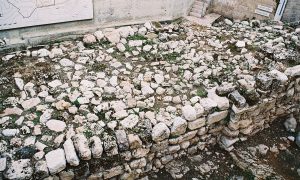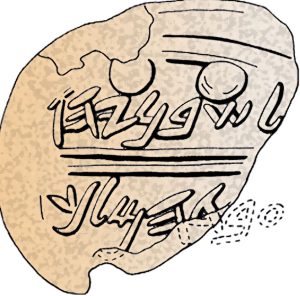Who was King Hezekiah’s most important contemporary? If you said the prophet Isaiah, give yourself points. But if you said Shebna, then you clearly have been learning Gemara and not Bible. While Shebna appears as a relatively minor character in the books of Isaiah and Kings II, in our Gemara he is a leader on a par with the king:
“Wasn’t there Hezekiah? There was Shebnah” [who was Hezekiah’s equal in Torah knowledge.] (Sanhedrin 36a)
In fact, he seems to have been even more popular than Hezekiah, as evinced by the number of his followers:
“He [Shebna] would teach Torah to 130,000, [whereas King Hezekiah] would teach to 110,000” (Sanhedrin 26a)
Elsewhere we learn that Hezekiah’s time period was one where there was widespread Torah learning:
“Rabbi Yitzḥak Nappaḥa says: The yoke of Sennacherib was destroyed due to the oil of Hezekiah that would burn in the synagogues and study halls . . . they searched from Dan in the north to Beersheba in the south, and did not find an ignoramus.” (Sanhedrin 94b)
While the descriptions of Hezekiah and Shebna teaching Torah to the masses may seem anachronistic, we have proof, if not of Torah, at least of widespread literacy in Hezekiah’s time. The inscription discovered inside Hezekiah’s tunnel (see here) shows us that even the lower-class workers who dug the subterranean tunnel knew how to read and write.
Despite Shebna’s learning, he was considered an evil man. He had bad moral qualities and indulged in a hedonistic lifestyle. Even worse, according to Sanhedrin 26, he betrayed his king and his people to the Assyrians. He was considered such a bad person that Rabbenu Tam argues that the Gemara citing someone named Shebna of Jerusalem must be incorrect since no one would name their child after such an evil person (Tosafot Shabbat 12b).
In the Bible, Shebna appears with two different titles. He is called a scribe and is mentioned alongside others like Elyakim ben Hilkiah, in a delegation that go to hear the Assyrian general speak as he besieges the walls of Jerusalem:
“But the king of Assyria sent the Tartan, the Rabsaris, and the Rabshakeh from Lachish with a large force to King Hezekiah in Jerusalem. They marched up to Jerusalem; and when they arrived, they took up a position near the conduit of the Upper Pool, by the road of the Fuller’s Field. They summoned the king; and Eliakim son of Hilkiah, who was in charge of the palace, Shebna the scribe, and Joah son of Asaph the recorder went out to them” (Kings II 18:17-18)

The Broad Wall of Jerusalem, from the time of King Hezekiah
Lior Golgher, CC BY-SA 2.5 <https://creativecommons.org/licenses/by-sa/2.5>, via Wikimedia Commons
But Shebna also is described with a much more lofty title than scribe: asher al habayit, literally he who is responsible for the house. This is sometimes translated as Royal Steward and seems to have been a key position in the ancient monarchy. The Bible tells us about others who are al habayit: Ovadiah the steward of King Ahab (Kings I 18:3) is one of them.
Shebna is singled out by the prophet Isaiah for illicitly carving out a grave for himself in Jerusalem:
“Thus said my Sovereign God of Hosts: Go in to see that steward, that Shebna, in charge of the palace: What have you here, and whom have you here,
that you have hewn out a tomb for yourself here?” (Isaiah 22:15-16)
Why is Isaiah angry with Shebna for making himself a grave? Some commentaries like Rabbi David Kimchi suggest that Shebna is a foreigner and has no right to be buried in Jerusalem. Others point to our Gemara and explain that Shebna hoped to depose Hezekiah and eventually be buried among the kings of Judah.
What can we learn about Shebna from archaeology? In 1870, in the course of excavations by the Arab village of Silwan, near the City of David, Charles Clermont Ganneau discovered a tomb cut out of the bedrock of the cliff. It had a large doorway, four meters high and eight meters long. Above the door was a panel with writing carved into it. The panel had been vandalized and parts were broken but you could clearly see letters in the ancient Hebrew script. Clermont Ganneau understood that this was a burial cave, part of the large necropolis in the Kidron Valley. However, he was unable to read the writing. The inscription was brought to the British Museum and remained undeciphered for eighty years.

Mustafaa at English Wikipedia, CC BY-SA 3.0 <http://creativecommons.org/licenses/by-sa/3.0/>, via Wikimedia Commons
In the 1950s, a young Israeli archaeologist named Nahman Avigad (later to excavate the Jewish Quarter of Jerusalem after the Six-Day War) took another look at the inscription and figured out what it said. His reading has been accepted as the correct one. The English translation of the inscription reads:
“This is the grave of . . .yahu asher al habayit. There is no silver or gold here, only his bones and the bones of his maidservant with him. Cursed is the person who opens this.”
To understand this inscription you have to know that ancient people, Jews and non-Jews, were buried with stuff – amulets, jewels, pots and more. Who knew what one would need on the journey to the next world? Naturally they did not want their grave broken open by robbers who would plunder it. There were not too many ways to deter robbers but this inscription is one of them. The author gave not one but two reasons to leave the grave alone: there is nothing valuable here! Second, if you open the grave you will be cursed. People took curses very seriously in those days, perhaps more so than they took the commandment against theft.
Unfortunately the grave was found empty, indicating that these warnings were ineffective. Who did the grave belong to?
Sadly the one part of the inscription that is damaged is that of the name. The suffix “yahu” could apply to many many Biblical names. But the title of asher al habayit is much less common and there is also the intriguing connection to Isaiah’s attack on Shebna carving out a grave. The writing is similar enough to that of the Shiloach inscription to be dated to Hezekiah’s time. Could this be Shebna(yahu)’s grave?
Another less famous but significant artifact relating to Shebna was discovered in Lachish in the 1960s. Lachish was King Hezekiah’s second most important city and we have discovered many artifacts there that connect to his reign as well as to its conquest by the Assyrians. A bulla (seal impression) was discovered in Lachish that said on it “Shebnayahu . . .the king.” More recently, a similar bulla was found on the antiquities market that said “שבניהו . . ד המלך,” which seems to mean Shebnayahu eved (servant of) the king. Nice proof that Shebna worked for the king and could also have gone by Shebnayahu.

A drawing of the bulla
תמר הירדני, Attribution, via Wikimedia Commons
What’s next for Jerusalem archaeologists? How about a flier announcing Shebna’s next public Torah class, held in a hall that could accommodate 130,000 people?










